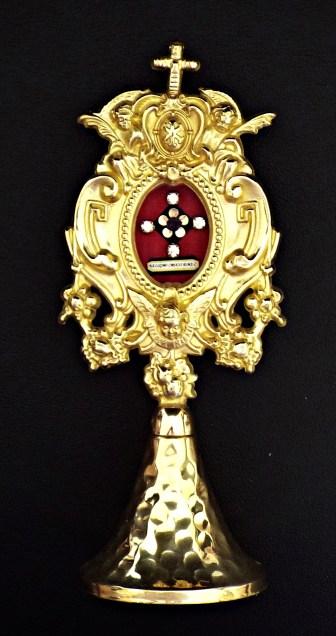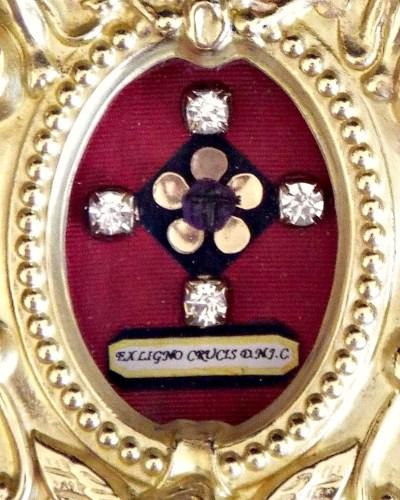
Relics of the True Cross
After the death of Jesus Christ, the very last thing the leaders of the Jews wanted at the time was any mention of Christ being able to rise from the dead (Mayo, 2018). They had heard enough of that in the preceding years and wanted no more of it. For them it was blasphemy. Thus, to prevent such a thing from happening, after Christ died, the Jews proceeded to dump the wood of the Cross into a ditch and covered it over with several boulders to prevent it from ever being found. But in 320, the aged Saint Helena[1] visited Jerusalem in the hope of learning more about Christ’s life and the places where He had been (Socrates Scholasticus, 1984).
With the support of both her son and Saint Macarius of Jerusalem,[2] Helena ordered that the 2nd century temple to Venus,[3] which had been built upon what was suspected to be the tomb of Christ, be destroyed and replaced by what is today known as the Basilica of the Holy Sepulcher (ibid.; Eusebius of Caesarea, 4th cent.). But as workers were carrying out the demolition and excavation works in compliance with Helena’s request, under the religio-jurisdictional supervision of Macarius, three crosses were found buried among the rubble on September 14:[4] the Cross of Christ, with the titular inscription I. N. B. I.[5] still attached to it; and the crosses of Saint Dismas, the good thief, and Gesmas, the bad thief (da Varagine,[6] 1260).
Macarius ordered that the three crosses be placed alternatively upon a woman who was so ill that she was considered to be on her deathbed (Socrates Scholasticus, 1984). The woman is said to have recovered when touched by the third cross, which was the Cross of Christ with its inscription.
A large part of the True Cross of Christ was then placed in a silver casket and has remained at the Basilica of Holy Sepulcher, Jerusalem (Marucchi, 1908; McClure, 1919). A second large part was later taken to Rome, Italy, and placed for veneration at the Basilica della Santa Croce in Gerusalemme, which was also built by Helena. A third large part was taken by the queen to the palace in Constantinople (now Istanbul, Turkey), where Constantine proceeded to declare the city impregnable to enemy attacks. Smaller parts of the Cross were broken up into fragments and widely distributed to the faithful throughout the world.

From the wood of the True Cross
Saint Cyril of Jerusalem (c. 350) declared that
The holy wood of the Cross bears witness, seen among us to this day, and from this place now almost filling the whole world, by means of those who in faith take portions of it.
Significant parts of the Cross can, among others, also be found at the Monastery of Koutloumousiou on Mount Athos, Greece; the Cathédrale Notre Dame de Paris, France; the Metropolitan Cathedral of the Assumption in Pisa, Italy; the Monastery of Santo Toribio de Liébana, Spain; and at the Monasterio de Tarlac in San Jose, Philippines.
Presented above are photographs of two small relics of the True Cross in a sealed brass reliquary, together with their detail. They are placed one upon the other to form of a cross. These fragments of the Cross of Christ come from that part of the True Cross that can be found in Istanbul. Their provenance was certified in 2004 by Paul Karatas, then Archbishop of the Chaldean Eparchy of Diarbekir, Turkey.
———-
[1] Mother of the Emperor Constantine.
[2] Macarius was the bishop of Jerusalem from 312 to 335.
[3] The goddess of love, beauty, sex, fertility, prostitution, and victory (Garcia, 2013). Venus was the mother of Hermaphroditos who epitomized androgyny.
[4] In 335, this day was proclaimed thenceforth in the Church as the Feast of the Exaltation of the Holy Cross (or Triumph of the Holy Cross), with the first feast being held on the dedication of the Basilica of the Holy Sepulcher (Holy Sepulcher, n. d.).
[5] Iησοῦς ὁ Ναζωραῖος ὁ Bασιλεὺς τῶν Ἰουδαίων [Jesus the Nazarene, King of the Judeans] as had been ordered to be written by Pontius Pilate despite the objections raised by the Jewish leaders: “O γέγραφα γέγραφα” [What I have written, I have written] (Brown, 1988; cf. Ps 56, 57).
[6] Blessed Jacobus da Varagine was the archbishop of Genova from 1288 until his death 10 years later. According to da Varagine, the Cross of Christ was made from the different types of wood of three trees, the seeds of which had been planted by Seth in the mouth of Adam’s corpse during his father’s burial. These trees of cedar, cypress and pine (Roman, 2005; cf. Is 60:13) were said to have sprouted in one spot from the seeds of the Tree of Mercy in the Garden of Eden. The wood from the three trees had been used to build Solomon’s Temple in Jerusalem.

